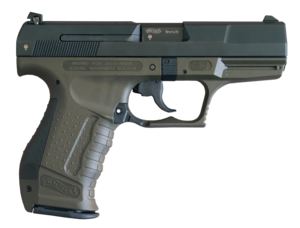Walther P99
From Wikipedia, the free encyclopedia
| Walther P99 | |
|---|---|
 Walther P99 Military, 9 mm version with green polymer frame | |
| Type | Semi-automatic pistol |
| Place of origin | |
| Service history | |
| Used by | Polish police, Finnish Defence Forces, German police (partial), Montreal Police Service |
| Production history | |
| Designer | Carl Walther GmbH Sportwaffen |
| Designed | 1993-1996 |
| Manufacturer | Carl Walther GmbH Sportwaffen |
| Produced | 1996-present |
| Variants | P99QPQ, P99 Military, P990 (P99DAO), P99QA, P99AS, P99C, P99C AS, P99C QA, P99C DAO, SW99 |
| Specifications | |
| Weight | 630 g (22.22 oz) (9x19mm Parabellum model) 655 g (23.1 oz) (.40 S&W model) |
| Length | 180 mm (7.1 in) (9x19mm Parabellum) 184 mm (7.2 in) (.40 S&W) |
| Barrel length | 102 mm (4 in) (9x19mm Parabellum) 106 mm (4.2 in) (.40 S&W) |
| Width | 29 mm (1.1 in) (9x19mm Parabellum) 32 mm (1.3 in) (.40 S&W) |
| Height | 135 mm (5.3 in) |
| | |
| Cartridge | 9x19mm Parabellum 9x21mm IMI .40 S&W |
| Action | Short recoil operated, locked breech |
| Muzzle velocity | 408 m/s (1,339 ft/s) (9x19mm Parabellum) 344 m/s (1,129 ft/s) (.40 S&W) |
| Feed system | 16-round detachable box magazine (9x19mm Parabellum) 12-round box magazine (.40 S&W) |
| Sights | Interchangeable 3-dot notch sight |
The Walther P99 is a semi-automatic pistol made in Germany by Walther Sportwaffen.
The design of the P99 was initiated in 1994, and the handgun was presented in 1997. The main goal was to develop a new, modern-style police and self-defense handgun that incorporated all the latest developments and would cost less than its predecessor, the Walther P88, which did not achieve any significant commercial success. The pistol is used by the German Police of some federal states of Germany and the Finnish Army's special forces and military police, where it goes under the designation Pistooli 2003 (PIST 2003).
Design details
The P99 uses an internal striker as opposed to an external hammer, with a red-painted striker tip that protrudes from rear of the slide when the gun is cocked, as well as a chamber loaded indicator on the right side of the slide. It also features four internal safeties, a decocking button, sights adjustable for both windage and elevation, tool-less takedown, accessory rail, interchangeable grip backstraps of varying sizes for different users, and an ambidextrous magazine release incorporated into the trigger guard.
Redesign
A redesigned P99 was presented in 2004, incorporating a modified trigger guard that eliminated the "ski hump", which is clearly visible in the accompanying images. This was done to address some users' comfort concerns regarding the previous style. Walther also took the opportunity to redesign the slide so the user could grip it more easily, and notably, change the proprietary accessory rail to a Weaver type. Some models built in 2005 and all later models received one more design change, an elongated magazine release.
Variants
P99AS (Anti-stress)
Single/Double action. Prior to 2004 there was no designation for the double action trigger which Walther now markets as the P99AS ("anti-stress") trigger. It is called anti-stress because the trigger pull is the same length for the first shot, regardless of single or double-action. In this way, the anti-stress trigger functions as a sort of two-stage trigger, and lessens the possibility of stress-induced negligent discharges.
P99DAO (Double-action only)
The P99DAO was previously produced as the P990.
P99QA (Quick-action)
Glock style action with preloaded striker (shorter, lighter pull). The P99QA was announced in 2000.
P99C (Compact)
Compact version of the P99 available in the 3 preceding action types.
Limited editions

The MI-6 Limited Edition
Walther has also created several limited production runs of the P99 including:
- MI-6 (James Bond) a marketing tie-in with the new James Bond movies
- La Chasse (hunting)
- Year 2000 (Millennium)
Smith & Wesson SW99
Closely related to the P99, the Smith & Wesson SW99 is a joint venture between Walther, who produces a modified receiver in Germany, and Smith & Wesson, who fabricates the slides and barrels in the United States. Magazines can be interchanged between the two variants, but the pistols are considered to be two separate types, and are easily distinguished from each other by the trigger guard and slide design. The SW99 is also available in .45 ACP, while the P99 is not.
Although some Walther P99s carry the proof mark "SMITH & WESSON Springfield, MA" this only denotes importation by Smith & Wesson (currently the official importer) and not that it was manufactured by them. An "eagle over N" proofmark on the frame, barrel and slide is present on all German made P99s.
Gallery
See also
- Walther P22, a smaller version of the Walther P99 chambered in .22 LR.
- Umarex air pistol
References
| This article or section includes a list of references or external links, but its sources remain unclear because it lacks in-text citations. You can improve this article by introducing more precise citations. |


